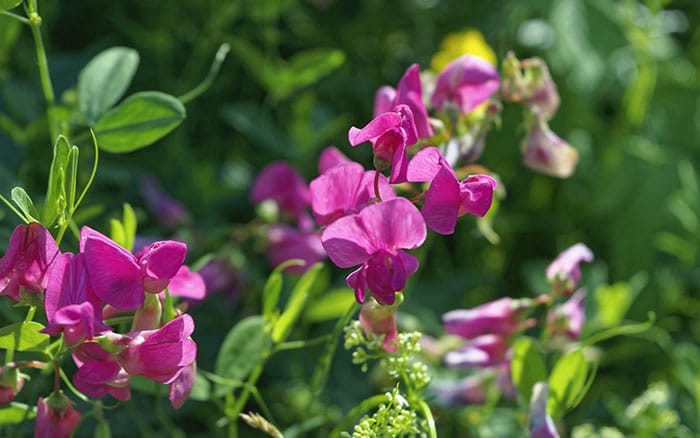The preliminary results of my Great British Flower Poll 2018 are now in.
The poll is in honour of British Flowers Week (18th-24th June 2018). Check out the brilliant blooms that are currently ranking in the top 5 below or take part to change the order in time for the final results (ends: 24th June).
5. Sweet pea
Weighing in at a very healthy 5th place are the delightfully scented easy-going flowers of Lathyrus odoratus (Sweet pea). Legend has it that they were first introduced to England by a Sicilian monk in the 17th century. These skilful climbers look amazing scaling wigwams in sunny borders or scrambling up trellis on a garden wall. As part of the legume family, Sweet peas capture nitrogen from the air and seal it into the soil, making them fantastic natural soil improvers.


4. Dahlia
Next in line are the showy blooms of the Dahlia family. Available in an array of resplendent colours, these sumptuous blossoms will keep flowering right up until the first autumn frost. Anders Dahl, the 18th century Swedish Botanist after whom they are named, regarded Dahlias as a vegetable, since they have edible tuberous roots. Adorn your garden patio with these bad boys this summer and you’ll be delighting your visitors for months to come.
3. Bluebell
Third place goes to Hyacinthoides non-scripta (Bluebell). Forming lavish azure carpets in woodlands across Britain each spring, it’s no wonder they are one of our collective favourites. An important early nectar source for bees, Bluebells are even protected by law—uprooting a single bulb could cost you a whopping £5000 in fines! Emily Brontë, who says that ‘The Bluebell is the sweetest flower,’ may be disappointed to see our poll placing it at number three.


2. Peony
In second place are the luxurious plump heads of the exquisite Paeonia lactiflora (Peony). For magnificent homegrown cut flowers, you cannot beat the sweetly-scented, ruffled pink blossoms of the ‘Sarah Bernhardt’ cultivar. Contrary to popular belief, Peonies do not require ants to bloom—although ants do love the sweet nectar that Peonies produce. Simply dunk cut flowers upside down into a bucket of cold water to get rid of ants before taking indoors.
1. Rose
Topping the charts at present is the charming and quintessentially English Rose.

Roses are a staggering 35 million years old, appearing in the fossil record at the same time as primates. The oldest living rose, which grows on the wall of Hildesheim Cathedral in Germany, is thought to be a thousand years old.
Roses have long been regarded as stunningly beautiful flowers. The Ancient Greeks painted them on palace walls in Ancient Crete in around 1600BC, while the Romans used thick rose petal carpets to decorate the floors of banqueting halls.
Roses have even been into space! In 1998, a miniature rose named ‘Overnight Scentsation’ was taken out of the Earth’s orbit to determine the effects of zero gravity on fragrance. The result? Roses are fragrant in space, but do not smell the same as they do on Earth.
With a huge variety of flower shapes and colours on offer, there is a Rosebush to suit everyone’s tastes.

One of my absolute favourites is the brand new ‘This Morning’ Rose, which was launched at the RHS Chelsea Flower Show 2018. When you look at roses like this, it’s no wonder they are colloquially known as ‘The Queen of Flowers.’
Forgotten beauties



Where are the Lupins and Foxgloves? Where are the Hollyhocks and Tulips? These beautiful flowers came in at joint 14th place (Lupins and Foxgloves), 25th place (Hollyhocks) and 18th place (Tulips).
Primrose, Cornflower and Brodiaea linger almost forgotten at the bottom of the list, receiving just one vote each so far, while the brilliant blooms of Muscari and Stretocarpus have, as yet, received zero votes.

Leave A Comment